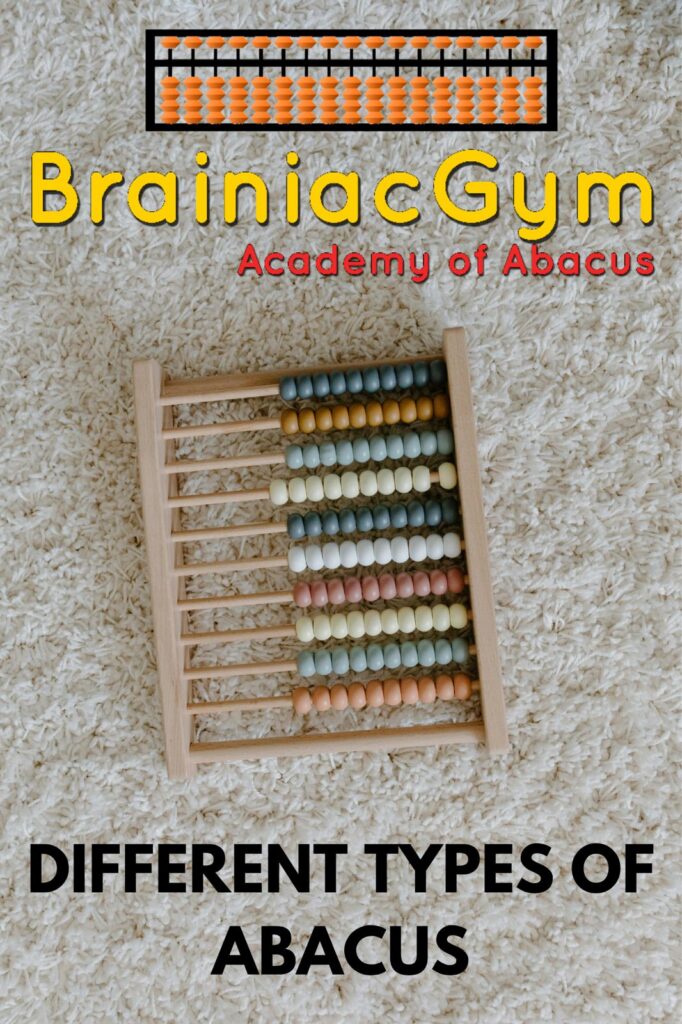Different Types of Abacus
We will transport you back to the history of the abacus tool. It will be necessary to explain many kinds of abacus tools in depth. We are deepening the differentiation of a few historical peculiarities that make them extraordinary. Products that created Inspiration among people.

A Brief on Abacus and Various Kinds of It
Once you start learning an Abacus, The use of abacus instruments while carrying out the basic arithmetic is the conventional method. However, as kids advance to a new level, the teachers encourage them to involve more reasoning that entails mental imagery, focus, and understanding. Originally, the Abacus was used for many mundane computations Merchants and businessmen counted their money and traded. Modifications and inventions are indeed part of human life, this is true in both the developed and the developing societies. Thus, different types of abacus tools have been in existence since the ancient period. There are very few abaci that have left historical footprints in the record. However, some records in the texts are lacking and it becomes difficult to fathom when, where, and what concerning that abacus tool. Each tool is individual, they are produced from different materials and often consist of many pieces. Some of the parts of the Abacus tool are the frame, the rods or beams, the cups and/or compartments, and the numbers. Although there may be many types of Abacus, there is something very alike in all of the abacuses _ rods, frames, beats and so on, and their forms.However, Since the earliest timeline of human development, numerous countries have developed Abacus, and it has faced some changes in previous years since it was commonly used.
Here are the Basic parts of every standard abacus:
Its structure is rectangular/square which is referred to as a frame.
The Major segment beats are referred to as earth beats.
The corresponding beats of the Minor segment are known as ‘heaven beats’.
List of all the abacus tools:

Soroban Abacus
Indian Abacus
Roman Abacus
Schoty Abacus
Chinese Abacus
Cranmer Abacus
Sumerian Abacus
Let’s discuss in brief about different types of abacus:
How to use the abacus tool:
Naturally, with the help of the abacus tool, you can perform various calculations; including addition, subtraction, multiplication, division, counting decimals, fractions, squares, and even cubes.
Here, for clarity, three aspects are used: First, it is necessary to acknowledge the phase value of Understanding; Secondly, Upper and lower beads exchange.
The Suanpan abacus tool:
The Chinese Abacus also has another name the Suanpan.
The records of the history could date even to the ancient period_ specifically the period of the Eastern Han dynasty of imperial China, in the year 190 of the common era. Since then, the Chinese Abacus_ an intrinsic part to use in solving mathematical computations and rudimentary factors of mathematics. It has been widely implemented in almost all the provinces in China to encourage elementary school kids to do speed math calculations.
In the past, It was utilized as the fundamental exam that was required for accountants and financial managers until the year 2004. Modern usage of the Chinese abacus is very minimal. The Suanpan is about twenty cm in height, the frame can be wood or metal, and the instrument has two parts, the upper beads or the heaven beads and the lower beads or the earth beads. It is split by one slender horizontal bar that is normally called a unit pointer. There are two upper beads and five beads on the one which is located at the bottom of the row. China also has its own Abacus, and the one most commonly used today is close to the 4+1 beads model. This is the view to the right of the leftmost bead that depicts the initial numeral value of 1, the bead right next to it is 100, the next to it is 1000, and the following one is equal to 10000, and so on.
The Soroban abacus tool:

Called the Soroban abacus, the Japan Abacus is typically used in soroban education.
Soroban’s foundational design is based on the Suanpan Abacus of Chinese Origin whereas the number of beads that it got is due to the Roman Abacus. The Soroban abacus was introduced to Japan from China in approximately the 14th century. As with the earlier works, the standard Abacus here indicated is 13 rods. While the arrangements of the rods can be in odd numbers 7,9,11,13,15,17… 31 or more. The main difference between the soroban abacus and the suanpan is that while they both have beads, the beads’ locations are different. In the upper segment of the rods, their upper beads are only one; On the other hand, in the lower segment, the rods contain four beads.
It seems that a standard Japanese abacus is of a 1:4 proportion in size. Moreover, other Japanese abaci are associated with the 2:5 and 3:5 proportions. Normally, in Japan, learning anzan is done in sequence with learning Abacus, and it forms part and parcels of each speed calculation.
The Roman Abacus:
Romans have been in the habit of using various aids to ease the task of computation. It was ringing from pebbles, human calculators and, chicks. Glass Roman Abacus was also derived in the 11 century as a result of Gerbert d ’Aurillac otherwise known as Pope Sylvester II. Later, the Abacus was re-constructed into a more mobile tool in the form of eight large grooves of beats and tracks. This one is also called the Wax abacus. Sumerian Abacus:Sumer was an ancient region located in the historical part of the Middle East that was inhabited by the Sumerians somewhere in the period between 2700 and 2300 BC A single frame with multiple columns has beads in it and is arranged into 60 bases.
Indian Abacus tool:
The description of the ekanka or vartik mentioned in the scriptures mentioned above clearly shows that India has been using tools for calculations even from the ancient period. In India, we extensively use the Abacus, particularly for elementary classes education. The Indian Abacus which is in use today in India is much similar to that in China or Japan for instance. Standard abacus tool 17 rod is portable and can be taken from one place to another Hence, it is easily accessible.
Schoty or The Russian Abacus:
There is a multiplicity of the abaci but the Russian abacus commonly known as schoty, counts beads. It was established in the 17th century for trading and to determine currency precisely. Metals or woods are used in developing the fundamental structure of the schoty frame. There are eleven rows and ten beads; the eighth row only has four beads, and all the beads at the fifth interval are of a different colour. What distinguishes it is that_ It does not have any columns while the schoty beads are of different colours.
Cranmer Abacus:
In 1962 Terence. V Cranmer developed the Cranmer abacus for visually impaired children and adults. Later, the Cranmer abacus is adapted from the soroban in the present style. The Cranmer abacus has white beats that are provided with a piece of fabric put behind the back so that the beads do not move. As indicated the parallel rods are comfortably fitted into the rectangular black frame; the frame has been divided into two parts an upper and lower part. SUBSECTION A is made up of one white bead in the upper section, while the lower section incorporates four beads.
Which abacus is currently in use around the world?
Abacus simply enables your kid to learn arithmetic calculations. In other words, there are no best practices that define when and which tool is the appropriate one. The type of abacus that individuals in India prefer is the Modern Abacus, also known as the Japanese Abacus.
ENROLL YOUR KIDS NOW TO AVAIL THE BEST SERVICES IN ABACUS EDUCATION AND VARIOUS OTHER COURSES FOR THE HOLISTIC AND OVERALL DEVELOPMENT OF YOUR


